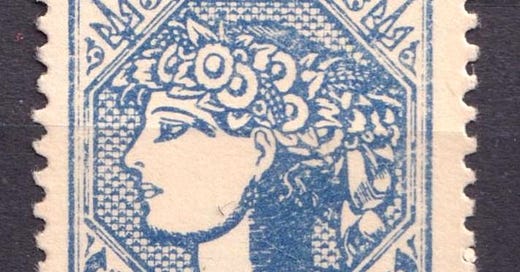Ukraine's turbulent history, in stamps
Oldlouis offers some of the country's elusive philatelic items of the 1920s
[Oooops! My email newsletter omitted the links to the sale. I have added them below.]
Ukraine, thanks to its location and natural riches, has been at the core of many of Europe’s conflicts for the last 110 years. Not surprisingly, much of its troubled history can be read in its stamps, both official and unofficial.

I’ve written about tracing Ukrainian history through its stamps for Linn’s Stamp News; my friend Andrew Oleksiuk has a fantastic hour-long presentation on YouTube that takes a topical approach to recounting 1,000 years of Ukrainian history and culture through its stamps.
Philatelically, the most intriguing period was from the collapse of Czarist Russia in 1917 to the incorporation of Ukraine into the Soviet Union in 1923. This saw a variety of provisional and regular issues for the nascent states of Ukraine and Western Ukraine, as well as occupation issues from the various armies marching back and forth across Ukrainian territory.

From time to time, an auction pops up with a good selection of some of these historic issues. Oldlouis, based in North Carolina, offers two such sessions this month as part of its three-week series of sales focused on Central and Eastern Europe.
The first Ukraine sale takes place Aug. 20 at 2pm EDT with over 300 lots covering issues of the People’s Republic of 1917-1920, Western Ukraine, and various occupations, as well as cinderellas issued in the Ukrainian diaspora; the second sale is on Aug. 23 at noon and consists of nearly 500 lots of provisional Trident overprints, issued in 1918 during the early days of Ukrainian independence from Imperial Russia.

Many of these lots start for as little as $1, allowing anyone to form an affordable selection of the items that appeal to them.
The scars of Ukraine’s history lay bare in some of these lots, such as the local-post issues of Liuboml, a western Ukrainian town whose population before World War II was 94% Jewish. It was utterly wiped out by Nazi occupiers during the Holocaust.

Thirty years earlier, however, it had been a thriving market town in the Volhynia district on the western edge of Russia. In the upheavals of 1918, a local post was organized and a set of stamps were issued, depicting a town scene and with inscriptions in no less than four languages, testifying to the polyglot inclusivity of the area: Ukrainian, Polish, German and Yiddish.
The lots mentioned here offer just a taste of the array of fascinating and historically significant material in the sale. At a time when the free world is being called upon to help Ukraine stave off an existential threat, it is important to remember that Ukraine has suffered terrible hardships in the past, too, and that the legacies of those hard times can often be found in our stamp albums.
Til tomorrow,



